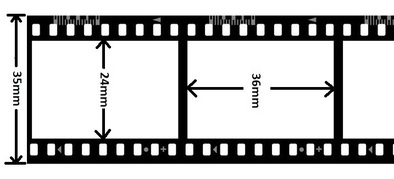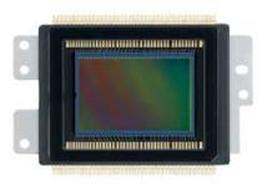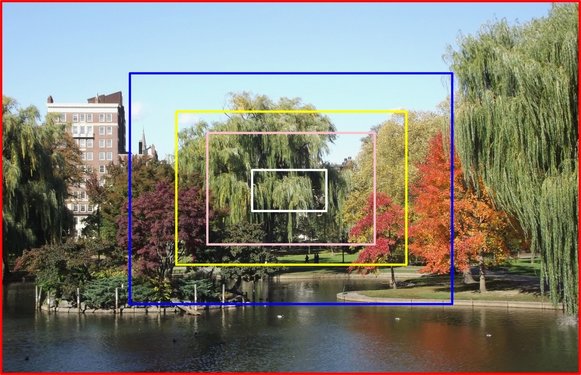What is a 35mm Equivalent Focal Length?
You may have come across the term "35mm equivalent" when viewing information about digital camera lenses and their focal lengths.
The term 35mm equivalent focal length is a comparison of the field of view seen through a digital camera lens compared to the field of view produced by the older 35mm film cameras.
35mm cameras were the most commonly used cameras before digital cameras became the norm. They were called 35mm cameras because the actual width of the film that was used with them (including the sprocket holes for advancing the film) was 35mm.
The term 35mm equivalent focal length is a comparison of the field of view seen through a digital camera lens compared to the field of view produced by the older 35mm film cameras.
35mm cameras were the most commonly used cameras before digital cameras became the norm. They were called 35mm cameras because the actual width of the film that was used with them (including the sprocket holes for advancing the film) was 35mm.
The diagram of the film strip above shows the dimensions of the 35mm film including the 24mm X 36mm imaging area. (the light capturing area of the film)
Digital cameras use image sensors rather than film to capture the light that will produce a digital picture. Different types of digital cameras have various sized image sensors and the size of the image sensor will have an impact on the field of view seen through the camera lens.
So, going forward, remember that the term 35mm equivalent focal length is a reference to the field of view or angle of view of a digital camera lens compared to that of a "35mm camera".
Comparison of Fields of View. The full image area below shows the field of view you would see if the picture were taken with a 35mm camera that uses 35mm film. (for the sake of this example, just assume that the 35mm camera was equipped with a 50mm focal length lens.)
The image also shows the different fields of view you will see from digital cameras that use various size image sensors to capture light from a scene rather than film. (That is, as long as the same lens and focal length is being used for each camera)
Digital cameras use image sensors rather than film to capture the light that will produce a digital picture. Different types of digital cameras have various sized image sensors and the size of the image sensor will have an impact on the field of view seen through the camera lens.
So, going forward, remember that the term 35mm equivalent focal length is a reference to the field of view or angle of view of a digital camera lens compared to that of a "35mm camera".
Comparison of Fields of View. The full image area below shows the field of view you would see if the picture were taken with a 35mm camera that uses 35mm film. (for the sake of this example, just assume that the 35mm camera was equipped with a 50mm focal length lens.)
The image also shows the different fields of view you will see from digital cameras that use various size image sensors to capture light from a scene rather than film. (That is, as long as the same lens and focal length is being used for each camera)
This image does not show the exact ratio of one image sensor compared to another.
This depiction is for general comparison purposes only.
This depiction is for general comparison purposes only.
Red Rectangle: The area inside the red rectangle represents the field of view that you would see through a 35mm film camera or a Digital Slr camera equipped with a full frame image sensor.
A full frame image sensor's light capturing area is about the same as that of 35mm film. (measuring 36mm X 24mm) Therefore, with all other things being equal, the field of view will be the same. Full frame image sensors are found on higher end Digital Slr cameras.
Blue Rectangle: The area inside the blue rectangle represents the field of view that would be seen if an image sensor that measures 23.6mm X 15.7mm were used. This size image sensor is found in most non professional Digital Slr cameras like the Nikon D3500. It is commonly known as an APS-C size image sensor. (the Canon APS-C image sensors are slightly smaller, 22.3mm X 14.9mm) Some Compact System Cameras like the Sony a6100 are equipped with APS-C image sensors.
Yellow Rectangle: This area represents the field of view you would see if a Micro 4/3 image sensor which measures 17.3mm X 13.0mm were used with a 35mm camera. This size image sensor can be found in many Compact System Cameras
Pink Rectangle: This is the field of view that would be seen if an image sensor that measures 13.2mm X 8.8mm (also known as a 1" sensor) were used with a 35mm camera. This size image sensor can be found on cameras like the Panasonic Lumix DMC-ZS100.
White Rectangle: This field of view is what you would get from using a 1/ 2.3 size image sensor in a 35mm camera. (actual measurements 6.16mm X 4.62mm) This is the sensor size which is found in most Basic Compact Digital Cameras.
__________________________________________________________________________________________________________
Are your favorite family and vacation pictures just sitting in your computer or cell phone? Put them all on display with a Digital Photo Frame. A wide variety of sizes, and types of Digital Photo Frames are available at Amazon.com
________________________________________________________________________________________________________________
Why are there different Fields of View?: Today's digital cameras use image sensors to capture the light that comes through the camera lens whereas 35mm cameras used film to capture the light. The light capturing area (imaging area) of most digital camera image sensors is smaller than the imaging area of film.
As you can see from the example above, the widest field of view is produced when 35mm film or a full frame image sensor is used. With each smaller sized image sensor, more of the outer areas of the scene are lost. (cropped)
For the record, the field of view from a 35mm film camera and its lens is the standard field of view to which digital camera fields of view are compared. That is why you will see the phrase 35mm equivalent used.
35mm Equivalent Focal Lengths: You can see that using the smaller image sensors with a 35mm camera and its lens may not provide an acceptable field of view.
So, today's digital cameras are equipped with various image sensor, lens size/focal length combinations. Those sensor and lens size combinations are designed to produce fields of view that are similar to the 35mm film camera field of view.
The primary way that digital cameras achieve a 35mm equivalent view is through the use of camera lenses with wider focal lengths. For instance, the actual focal length of the zoom lens on the Nikon A 900 compact digital camera is 4.3-135mm. That is the equivalent of a 24-840mm lens focal length on a 35mm camera. (the image sensor size is 1/ 2.3)
Many Digital Slr cameras like the Canon EOS Rebel T7i are equipped with an 18-55mm focal length lens as part of the basic camera kit. This camera uses an APS-C size image sensor. The 18-55mm focal length lens will produce a field of view that is the equivalent of a 28.8-88mm lens view from a 35mm camera.
So, the bottom line is that the standard fields of view from 35mm cameras can be duplicated by digital cameras with their smaller sensors and lenses by using wider focal length lenses.
How is 35mm Equivalent Determined? Calculating the 35mm focal length equivalent of a camera lens is done by using a number that is called the crop factor or the focal length multiplier. The crop factor or focal length multiplier represents the ratio of the size of an image sensor compared to 35mm film.
The 35mm equivalent chart below shows some of the current digital camera models, their image sensor sizes, and the crop factor number that applies to them. Also listed are lens focal lengths that might be used with them, as well as their 35mm focal length equivalent. .
The 35mm Focal Length Equivalent chart below should give you an idea as to how image sensor sizes and focal lengths are directly related to the 35mm equivalent field of view.
A full frame image sensor's light capturing area is about the same as that of 35mm film. (measuring 36mm X 24mm) Therefore, with all other things being equal, the field of view will be the same. Full frame image sensors are found on higher end Digital Slr cameras.
Blue Rectangle: The area inside the blue rectangle represents the field of view that would be seen if an image sensor that measures 23.6mm X 15.7mm were used. This size image sensor is found in most non professional Digital Slr cameras like the Nikon D3500. It is commonly known as an APS-C size image sensor. (the Canon APS-C image sensors are slightly smaller, 22.3mm X 14.9mm) Some Compact System Cameras like the Sony a6100 are equipped with APS-C image sensors.
Yellow Rectangle: This area represents the field of view you would see if a Micro 4/3 image sensor which measures 17.3mm X 13.0mm were used with a 35mm camera. This size image sensor can be found in many Compact System Cameras
Pink Rectangle: This is the field of view that would be seen if an image sensor that measures 13.2mm X 8.8mm (also known as a 1" sensor) were used with a 35mm camera. This size image sensor can be found on cameras like the Panasonic Lumix DMC-ZS100.
White Rectangle: This field of view is what you would get from using a 1/ 2.3 size image sensor in a 35mm camera. (actual measurements 6.16mm X 4.62mm) This is the sensor size which is found in most Basic Compact Digital Cameras.
__________________________________________________________________________________________________________
Are your favorite family and vacation pictures just sitting in your computer or cell phone? Put them all on display with a Digital Photo Frame. A wide variety of sizes, and types of Digital Photo Frames are available at Amazon.com
________________________________________________________________________________________________________________
Why are there different Fields of View?: Today's digital cameras use image sensors to capture the light that comes through the camera lens whereas 35mm cameras used film to capture the light. The light capturing area (imaging area) of most digital camera image sensors is smaller than the imaging area of film.
As you can see from the example above, the widest field of view is produced when 35mm film or a full frame image sensor is used. With each smaller sized image sensor, more of the outer areas of the scene are lost. (cropped)
For the record, the field of view from a 35mm film camera and its lens is the standard field of view to which digital camera fields of view are compared. That is why you will see the phrase 35mm equivalent used.
35mm Equivalent Focal Lengths: You can see that using the smaller image sensors with a 35mm camera and its lens may not provide an acceptable field of view.
So, today's digital cameras are equipped with various image sensor, lens size/focal length combinations. Those sensor and lens size combinations are designed to produce fields of view that are similar to the 35mm film camera field of view.
The primary way that digital cameras achieve a 35mm equivalent view is through the use of camera lenses with wider focal lengths. For instance, the actual focal length of the zoom lens on the Nikon A 900 compact digital camera is 4.3-135mm. That is the equivalent of a 24-840mm lens focal length on a 35mm camera. (the image sensor size is 1/ 2.3)
Many Digital Slr cameras like the Canon EOS Rebel T7i are equipped with an 18-55mm focal length lens as part of the basic camera kit. This camera uses an APS-C size image sensor. The 18-55mm focal length lens will produce a field of view that is the equivalent of a 28.8-88mm lens view from a 35mm camera.
So, the bottom line is that the standard fields of view from 35mm cameras can be duplicated by digital cameras with their smaller sensors and lenses by using wider focal length lenses.
How is 35mm Equivalent Determined? Calculating the 35mm focal length equivalent of a camera lens is done by using a number that is called the crop factor or the focal length multiplier. The crop factor or focal length multiplier represents the ratio of the size of an image sensor compared to 35mm film.
The 35mm equivalent chart below shows some of the current digital camera models, their image sensor sizes, and the crop factor number that applies to them. Also listed are lens focal lengths that might be used with them, as well as their 35mm focal length equivalent. .
The 35mm Focal Length Equivalent chart below should give you an idea as to how image sensor sizes and focal lengths are directly related to the 35mm equivalent field of view.
Camera Model |
Image Sensor Size |
Crop Factor |
Digital Camera Lens Focal Length |
35mm Focal Length Equivalent (Approximate) |
Full Frame 24 X 36mm |
1.0 |
24-105mm |
24-105mm |
|
APS-C 23.6 X 15.7mm |
1.5 |
18-140mm |
27-210mm |
|
APS-C 22.3 X 14.9mm |
1.6 |
18-55mm |
28-88mm |
|
Micro 4/3 17.3 X 13.0mm |
2.0 |
12-32mm |
24-64mm |
|
1" 13.2 X 8.8mm |
2.7 |
9.1-91mm |
25-250mm |
|
1/2.3 Sensor 6.16 X 4.62mm |
5.6 |
5-25mm |
28-140mm |
|
1/2.3 Sensor 6.16 X 4.62mm |
5.6 |
4.3-215mm |
24-1200mm |
Click on any camera model to learn more about its features
Each different size image sensor has a particular crop factor that is used to determine the 35mm equivalent of a camera lens. For instance the imaging area of film is 1.5 times larger than the imaging area of a Nikon APS-C image sensor. So the crop factor for that image sensor is 1.5.
If you wanted to know the 35mm equivalent of a 50mm lens used on a digital camera with an APS-C size image sensor, you would just multiply the 50mm focal length by 1.5. (50mm X 1.5 = 75mm) So, in this example, the 35mm focal length equivalent for the 50mm lens would be 75mm.
In other words, a 50mm lens on a digital camera with an APS-C size image sensor will give the same field of view as a 75mm lens on a 35mm film camera.
Here is another example. Most basic compact cameras have an image sensor size of 1/2.3. The crop factor for that size image sensor is 5.6. A compact camera with a 4.3 to 43mm zoom range has a 35mm equivalent zoom range of about 24to 240mm (4.3mm to 43mm X 5.6 = 24.08mm to 240.8mm)
So, that is what 35mm focal length equivalents are all about.
If you wanted to know the 35mm equivalent of a 50mm lens used on a digital camera with an APS-C size image sensor, you would just multiply the 50mm focal length by 1.5. (50mm X 1.5 = 75mm) So, in this example, the 35mm focal length equivalent for the 50mm lens would be 75mm.
In other words, a 50mm lens on a digital camera with an APS-C size image sensor will give the same field of view as a 75mm lens on a 35mm film camera.
Here is another example. Most basic compact cameras have an image sensor size of 1/2.3. The crop factor for that size image sensor is 5.6. A compact camera with a 4.3 to 43mm zoom range has a 35mm equivalent zoom range of about 24to 240mm (4.3mm to 43mm X 5.6 = 24.08mm to 240.8mm)
So, that is what 35mm focal length equivalents are all about.


